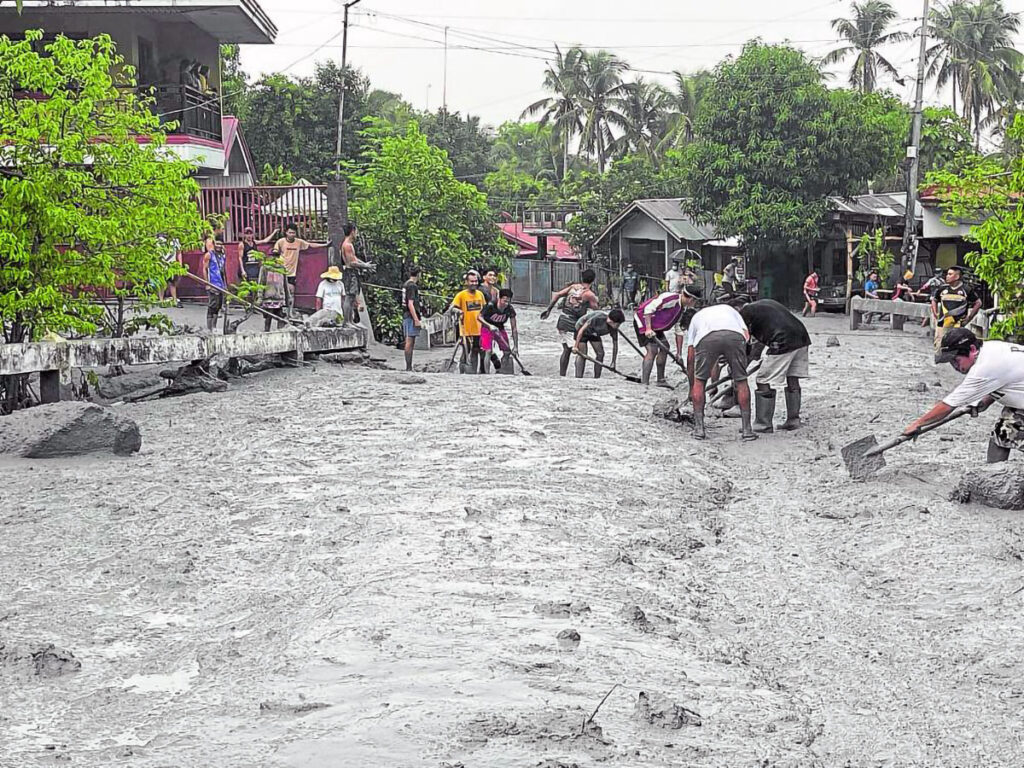
Residents of Barangay Biak na Bato in La Castellana, Negros Occidental, on Wednesday work together to clear lahar that covered the village’s roads and blocked the flow of traffic. Lahar flowed through the village’s streams and rivers after rains washed down ash and debris. (CONTRIBUTED PHOTO)
CEBU CITY, Philippines – The top official of the state volcanology and seismology bureau denied claims that they failed to warn the public about the eruption of Mount Kanlaon.
Since 2023, the Philippine Institute of Volcanology and Seismology (Phivolcs) has been issuing advisories and cascading reports to concerned government agencies, including local governments, about abnormal volcanic activity in Kanlaon, said its director Teresito Bacolcol.
READ:
Kanlaon Volcano Eruption: LIVE UPDATES
Kanlaon Volcano remains at Alert Level 2 – Phivolcs
‘Sulfur dioxide haze’ in Cebu? Pagasa-Mactan says there’s none
Lahar hits Negros Occidental town after Kanlaon blast
In fact, according to Bacolcol, they alerted national government offices on May 26 and local government units (LGUs) near Kanlaon to be vigilant after recording at least 24 earthquakes that day.
“Normally Canlaon would only have less than five earthquakes a day but on May 26, we recorded 24 earthquakes that is why we issued an advisory, then informing the LGU that they have to be vigilant,” said Bacolcol.
The bureau even recommended LGUs to ensure no one will enter the four-kilometer permanent danger zone, he added.
“Kay there is always this possibility nga magka phreatic eruption without warning. So mao to, on May 26, we issued an advisory because of the increasing number of earthquakes,” Bacolcol said.
The Phivolcs’ director’s statements came after local officials from Canlaon City reportedly did not receive any warning from their bureau.
Canlaon, a city in Negros Oriental and which lies on the eastern side of the volcano, was one of the severely affected by its phreatic eruption last June 3.
While there is no tool that will accurately predict a volcanic eruption, volcanologists and seismologists monitor seismic activities like earthquakes and emissions of sulfur dioxide gas as indicators of a possible eruption.
Phivolcs, in a report generated a day after Kanlaon erupted and spewed thick, ash cloud, stated that they upgraded the volcano’s Alert Level from 1 to Alert Level 3 due to increased seismic activities there.
They also observed an increase in emission of sulfur dioxide gas since May of last year, averaging 1,273 tons per day. A volcano usually emits less than 300 tons of sulfur dioxide per day, Phivolcs said.
“Since 2023, we already issued five advisories. More or less we already have an inkling of probably this is going to erupt anytime soon,” explained Bacolcol.
“Again, we already informed the public that they have to be vigilant and also the local government unit about the possibility nga this will have an eruption without warning,” he added.
As of Thursday, June 6, Alert Level 2 remains in effect over Kanlaon as Phivolcs, in its latest bulletin, recorded 27 volcanic earthquakes from midnight on June 5 to midnight of today.
Bacolcol has reminded those residing near Kanlaon to stay vigilant and stay away from the four-kilometer permanent danger zone to avoid getting caught in landslides and rock falls following the eruption.
He also advised those with respiratory problems to wear face masks to protect them from volcanic ashes.
“These can irritate the lungs and our respiratory tract. Usually ang mga tawo nga naay problema sama sa asthma, sila maoy vulnerable kaayo,” said Bacolcol.